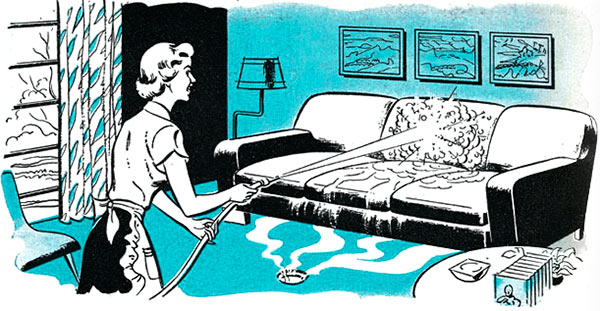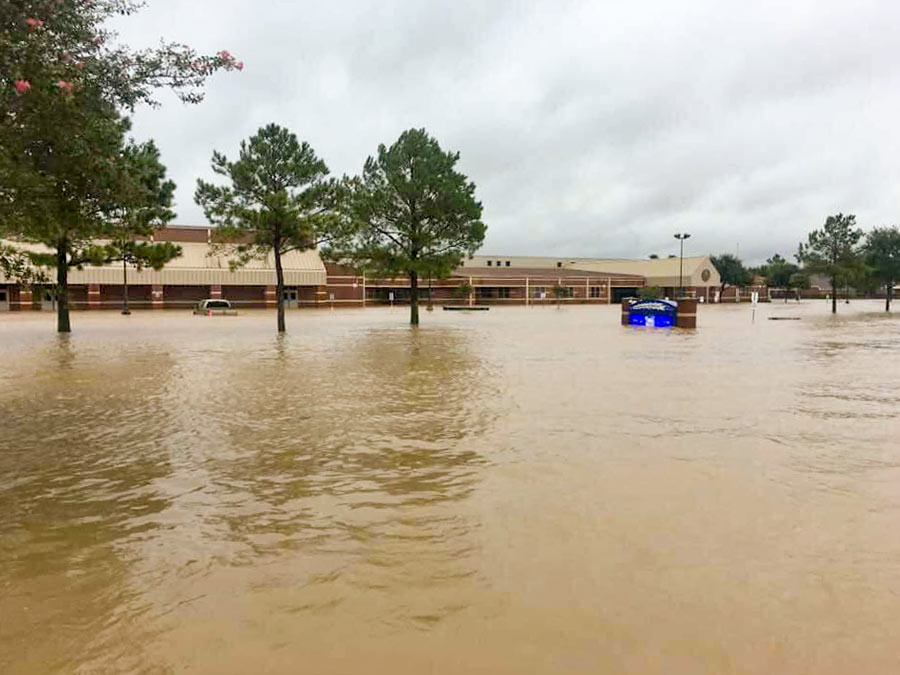WHERE ARE HOUSTON’S FLOODWATER-READY HOMES?  A reader asks: “Is there not a single architect in Houston who has envisioned a flood resistant home? Polished concrete floors with large area rugs instead of wood or wall-to-wall carpet? Waterproof material (instead of drywall) three or four feet up from the slab; removable of course so you can remove the wet insulation after the next flood? How much more do cabinets cost if they are made from marine grade plywood? Surely there’s a business case for a house that you can basically hose off and re-decorate after a flood, right?” Illustration: Popular Mechanics
A reader asks: “Is there not a single architect in Houston who has envisioned a flood resistant home? Polished concrete floors with large area rugs instead of wood or wall-to-wall carpet? Waterproof material (instead of drywall) three or four feet up from the slab; removable of course so you can remove the wet insulation after the next flood? How much more do cabinets cost if they are made from marine grade plywood? Surely there’s a business case for a house that you can basically hose off and re-decorate after a flood, right?” Illustration: Popular Mechanics





They are in Guam and in the tropics, They are made of cinder block and look like dog shit.
The military guys hate them. That’s what your looking for.
Was thinking about this as well. I was imagining a metal/plastic wainscoting that could be removed like you mentioned above. I noticed in videos of schools getting cleaned out that the interior walls were basically all tile, but don’t think that would go over well for residential uses.
Because drywall is such a great building material… vomit.
–
Indknt think there is much originality in architecture, just lots of sheeple sucking up to developers.
Throw in some quick-connect ports in the ceiling joists, furniture straps and a winch to hoist your belongings up off the floor and you’re on to something there.
Please build my house out of steel, concrete, and glass. Terrazzo flooring throughout. Fireorb fireplace. Some teak or walnut in the ceiling to add warmth and whimsy– if the ceiling’s high enough! Heck, maybe put the whole structure up on stilts.
I expect Houston highrise prices and rents to reverse their recent declines.
My wife and I have been discussing how to design such a home. In addition to what you list, we favor a utility room with the AC and hot water heater in it rather than in the attic. System tunnels in the wall for HVAC ducts, wiring, and piping, readily accessible for repairs. Metal roof. Doubt it would be code but it makes a lot of sense to use.
They could look good. We just got ceramic tile flooring that looks like distressed wood. I could live in a house coated with that stuff.
Probably cheaper and definitely more pleasant to just build on stilts instead of a slab. Keeps the structure out of flood water, and has the added benefit of not increasing impervious cover. This seems to be the default construction method on Galveston post-Ike.
Park a house boat on your lot and float up and down with the tide.
brilliant. comments are great .
what kind of materials and cleaners can wash out the 20,000 chemicals, varying toxic biohazards, poisonous insoluble residues, and alllla that stuff in the superfund sites???
there is no washing away the toxic mess that overcame the 1st responders.
Angostura: Or pier and beam like my old Montrose house. Slab homes flooded, mine did not. Bonus, the area under my house can soak up water vs. if it were covered by slab.
They already exist all around us and they withstood 40″ of rain in 3 days. It’s called pier and beam. Bonus, you can get to plumbing and electrical underneath.
Cody: I tried to explain pier-and-beam to someone who quoted me for flood insurance. They said it would cost MORE than for a slab house, despite the fact that the p&b puts it 3 feet above the ground and there’s a 2 foot pit below the house to collect extra water in. I think they consider the crawlspace a floodable area. Um….
Insurance companies seem to hate pier & beam.
But I imagine a floating house much like a boat dock…
Water &sewerage lines and electrical would all have to be flexible. Besides insurers and local authorities, that engineering would be the big stumbling block, I think.
The architect’s are there. The architects can a will design what you want. It’s the clients who do not want to go the extra mile for the services of an architect and choose to save money buy purchasing a cookie cutter home or having some salesman builder throw something up… and…and… there is no requirement for an architect to be involved with a majority of the residential projects and other buildings of limited size.
Architects are there.
Welcome to the Wheel Reinvention Convention! Humankind has built cities along water since around, oh, 10,000 BC or so. Many, many cities. In fact there’s one just to the SE of here.
@Dinner, so what have you designed to address this problem? Is there a website where I can buy your plans? Oh that’s right – you want to wait until someone comes up to and asks you to design this.
P&B foundations take time and care to build. A subcontractor can fill an entire neighborhood of slabs in a day for dirt cheap. Any construction engineer worth his salt knows that slab foundations make no sense in our climate, but cash considerations outweigh practical ones.
P & B foundations, the wood floors are easilier to save as well since they can air out form underneath.
I’m a ship designer with 20+ years of experience and I will say that a float-off house is absolutely feasible from a technical point of view. A quick check in the used barge market shows that you can get something house-sized (80′ by 30′) for $65,000. Of course building something on-site would cost a lot more than construction in a shipyard. Not sure how this compares to what a foundation costs. But you’d need to add in some kind of anchoring system so that your house doesn’t float away when it floods. And permitting would be a whole other kettle of fish. I’m available for moonlighting if any architect wants to investigate this for a client!
@survivor guilt, My home in Spring Branch was built in 54 and I love that the hot water heater is in the laundry room and not like most of my friends’ houses, in the attic.
@Cody,
Pier and beam is just short stilts, right? (My house is P&B and aside from the chilly floor downstairs in the winter, I love it.)
.
@Movocelot,
I’ve seen concepts for floatable houses. Just need to be careful with the height of the center of gravity. I’d hate for my floating house to capsize.
RE Pier & Beam: Some of the comments make it sound like P&B is better than a slab because it won’t flood since it’s higher above grade. But they will and do flood. Was involved in a Harvey cleanup of a P&B 3.5′ above grade. Still took a foot of water. Same headaches, same mess, and insulation under the floor to deal with. House had been there for years, never flooded. Maybe should have built it higher?
P&B foundations are more expensive than slabs but are good for reducing flooding for other people… so isn’t there a simple market solution to capture the flooding externalities? Namely, tax slabs and/or subsidize P&B. (And subsidize permeable driveways or tax concrete ones, while you’re at it.)
Interestingly, buildings on the Gulf Coast used to be built more or less like you’re suggesting.
.
Back in the 19th and early 20th century, Wainscoting wasn’t just decorative. It consisted of a sacrificial layer of material up to about 42″ above finish floor – that could be removed if it flooded. Many buildings had structural exterior walls of double wythe brick (later cinder block) that also does better in floods than wood framing.
.
This was lost sometime after World War II. And it’s not just buildings. Half the reason that people lost so much to the storm was that we don’t build furniture the way we used to either. It used to be solid wood and varnish – and those could stand up to a good soaking. Now it’s particle board, plastic laminate, and cushioned fabric all over – and the second those are soaked in floodwaters, they’re gone.
Have any of you paid attention to the home construction along Brays Bayou neighborhoods between Gessner and the Medical Center?
Pier and beam, way above ground level, concrete floors, metal studs – it’s all there.
@ JH: Yes, that’s exactly correct. Pier and beam foundations are hardly a lost art. Of course, when you figure that this only tends to be done for new McMansions on brownfield sites…well maybe that implies an important caveat. Greenfield development practices may still strongly favor re-grading land aggressively to elevate buildable area on lots and laying down slabs because that’s something that can be done cheaply at that scale.
.
To the issue of the cost of home/flood insurance on pier and beam versus slab, savings from elevating the living area might be offset by a higher replacement cost, hence the need for more coverage.
.
@ Orang Bodah: Something like a spud barge or jack-up barge would seem to do the trick. Floats when you need it to, but not away. But yeah, that’s a totally ridiculous luxury IMO, until and unless Houston real estate gets so pricey and insane that people start parking barge homes (as is done in Seattle) on the larger bayous and estuaries east and southeast of town. We aren’t there yet and I can’t imagine ever getting there.
@Steve,
The City DOES tax slabs!
Since 2011, your water bill includes a charge for the impervious cover on your lot. However, the rate isn’t large enough to change behavior.
Also, the city has largely miscalculated the impervious cover of P&B houses, assuming the area of the house as impervious cover. Very few people have bothered to correct the error.
@ Angostura: Unless there is a design or maintenance problem, pier and beam houses should not reduce the amount of runoff from the lot or improve permiability until and unless that lot becomes flooded. The crawlspace should remain dry, with stormwater draining to the street. If it is not dry, expansion and contraction of clay soils and the slow leaching-out of water-soluble minerals in the soil will lead to unusual foundation movement and standing water can lead to quite severe humidity and mold problems inside the house. The thing to really get worked up about was outdoor decks…that, and the whole process of getting that “fee” passed into law and administered.
Area wide solution: PERMEABLE CONCRETE
https://www.youtube.com/watch?v=8rbNznCBKI8